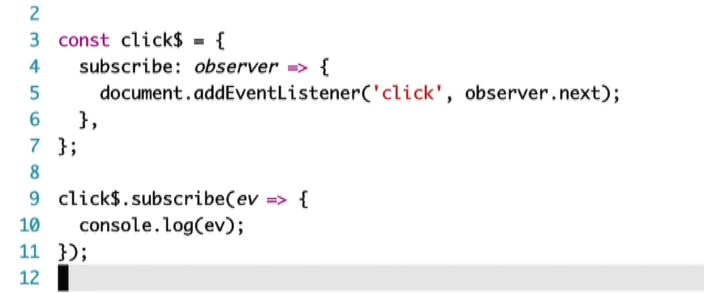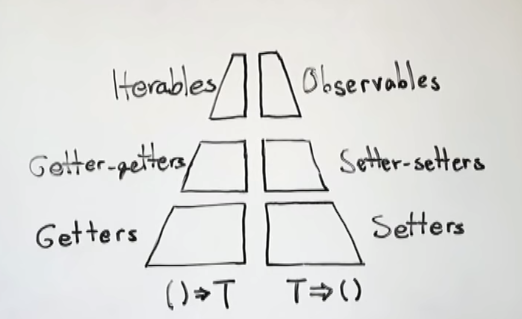[Javascript] Getter and Setter Abstractions
JavaScript provides primitive types and means of processing those. However, those are not enough. Real data must somehow come into the program and data must somehow leave the program, for it to become useful to us. In this talk, we will see how two abstractions are essential for data flow and to build up other abstractions, such as Iterator, Iterable, Observable, Scheduling, and others. Talk
Getter as abstractions:
const ten = ; // Abstractions
// Laziness
const getTen = () => { console.log("hi"); // hook for side effects // Implementation flexibility
return + ;
// return 2 * 5;
// return 10
}
Benefits:
- First of all: 'getTen' if you don't call the function, the calcuation inside the fucntion never run.
- You can do any side effects inside function.
- Implmentation flexibility, you can do different ways to aecieve the same effects.
Think about this code:
function add(getX, getY) {
const x = getX();
const y = getY();
return x + y;
}
'getX' and 'getY' are abstract. What we are doing now is adding two abstract number in concrete world. What if we add in abstract world?
function add(getX, getY) {
return () => { // put code into a get getter function
const x = getX();
const y = getY();
return x + y;
}
}
Now the function are complete lazy, lazyniess is a good thing, when you have some lzay you use getter can make things concrete.
function add(getX, getY) {
return () => {
const x = getX();
const y = getY();
return x + y;
}
}
const getTen = () => ;
const getY = Math.random;
const getSum = add(getTen, getY); // so far no calcuation happens
Lazy initialization and lazy iteration:
let i = ;
const array = [,,,];
function getArrayItem() {
// lazy iteration
return array[i++];
} console.log(getArrayItem());
console.log(getArrayItem());
console.log(getArrayItem());
console.log(getArrayItem());
console.log(getArrayItem()); // undefined
This is a concrete example, we call the fucntion mutiplue time and loop though the array.
And we also see that after call result as 'undefined', if we want to loop the array again from zero idnex, we have to do:
let i = ;
const array = [,,,];
function getArrayItem() {
// lazy iteration
return array[i++];
} console.log(getArrayItem());
console.log(getArrayItem());
console.log(getArrayItem());
console.log(getArrayItem()); i = ;
console.log(getArrayItem());
console.log(getArrayItem());
console.log(getArrayItem());
console.log(getArrayItem());
We call
i = ;
Of course this is not good at all, we leak the information.
The way to improve it is by using getter & lazyniess:
function getGetArrayItem() {
// lazy initialization
let i = ;
const array = [,,,];
return function() {
// lazy iteration
return array[i++];
}
}
let getArrayItem = getGetArrayItem();
console.log(getArrayItem());
console.log(getArrayItem());
console.log(getArrayItem());
console.log(getArrayItem());
getArrayItem = getGetArrayItem();
console.log(getArrayItem());
console.log(getArrayItem());
console.log(getArrayItem());
console.log(getArrayItem());
getter-getter: Abstract List:
Think about the following example:
function range(left, right) {
return () => {
// lazy initialization
let x = left;
return () => {
// lazy iteration
if (x > right) {
return undefined;
}
return x++;
}
}
}
const getGet = range( , );
const get = getGet();
console.log(get()); //
console.log(get());
console.log(get());
console.log(get());
console.log(get()); //
console.log(get()); // undefined
console.log(get());
console.log(get());
It prints out the range of nuber, which we defined, we can notice after the right limit of the number, it just print out undefined.
One way to solve the undefined problem is using for loop:
function range(left, right) {
return () => {
// lazy initialization
let x = left;
return () => {
// lazy iteration
if (x > right) {
return undefined;
}
return x++;
}
}
}
const getGet = range( , );
for(let get = getGet(), x = get(); x !== undefined; x = get()) {
console.log(x) // 10 ... 14
}
The good thing about this code is that no matter how large the range it is, the menory size is always 1. Every time you call the fucntion, it pull one value from the abstract getter function every time. It makes CPU and memory efficient.
Completion markers:
function range(left, right) {
return () => {
// lazy initialization
let x = left;
return () => {
// lazy iteration
if (x > right) {
return {done: true};
}
return {done: false, value: x++};
}
}
}
const getGet = range(, );
for(let get = getGet(), res = get(); !res.done; res = get()) {
console.log(res.value) // 10 ... 14
}
We added {done: true | false} as a complete marker.
Convert to Symbol.iterator:
function range(left, right) {
return {
[Symbol.iterator]: () => {
// lazy initialization
let x = left;
return {
next: () => {
// lazy iteration
if (x > right) {
return {done: true};
}
return {done: false, value: x++};
}
}
}
}
}
Javascript notice that when you are using [Symbol.iterator] and have 'next' inside, then it provides you a nice syntax to loop over the iterator and get the value of out it.
for(let x of range(, )) {
console.log(x) // 10 ... 14
}
We might have done this:
function range(left, right) {
return {
[Symbol.iterator]: () => {
// lazy initialization
let x = left;
return {
next: () => {
// lazy iteration
if (x > right) {
return {done: true};
}
return {done: false, value: x++};
}
}
}
}
}
for(let x of range(,)) {
if(x % === ) {
console.log(x)
}
}
We using 'if' inside 'for' loop, well it is nothing wrong, but we can do better. Because range() is abstract function, we don't need to pull all the value done to the concrete world to do the filtering, we can also do the filtering in abstract function.
const filter = pred => iterations => {
let z = [];
for (let x of iterations) {
if(pred(x)) z.push(x);
}
return z;
};
function range(left, right) {
return {
[Symbol.iterator]: () => {
// lazy initialization
let x = left;
return {
next: () => {
// lazy iteration
if (x > right) {
return {done: true};
}
return {done: false, value: x++};
}
}
}
}
}
for(let x of filter(x => x % === )(range(,))) {
console.log(x)
}
Setter-setter abstraction:
You can think of "setter-setter" is callback:
const setSetTen = (setTen) => {
setTen()
}
setSetTen(console.log) //
The benifits of doing setter-setter is
- Async
- Inversion of control
const setSetTen = (setTen) => {
setTimeout(() => {
//Async
setTen()
}, )
}
setSetTen(console.log) //
Setter-setter to Observable:


[Javascript] Getter and Setter Abstractions的更多相关文章
- JavaScript getter and setter All In One
JavaScript getter and setter All In One getter & setter JavaScript Object Accessors JavaScript A ...
- JavaScript getter和setter
对象的属性是由属性名name,值key,和其他特性(可读写性 writable,可枚举性enumerable,可配置性configurable)组成的.从ES5开发,提供了getter和setter ...
- javascript的getter和setter(转)
显然这是一个无关IE(高级IE除外)的话题,尽管如此,有兴趣的同学还是一起来认识一下ECMAScript5标准中getter和setter的实现.在一个对象中,操作其中的属性或方法,通常运用最多的就是 ...
- JavaScript中闭包实现的私有属性的getter()和setter()方法
注意: 以下的输出都在浏览器的控制台中 <!DOCTYPE html> <html> <head> <meta charset="utf-8&quo ...
- javascript中的function命名空間與模擬getter、setter
function的命名空間 在javascript中,function也可以擁有自己的命名空間例如以下這段程式碼: 12345678 function () { return 'I am A';} A ...
- javascript权威指南笔记--javascript语言核心(五)--getter和setter属性
getter和setter属性: var p = { x:1.0, y:1.0, get r(){ return Math.sqrt(this.x*this.x + this.y * this.y); ...
- javascript中的getter和setter
在ECMAScript 5中,属性值可以用一个或两个方法代替,这两个方法就是getter和setter var man = { name : 'lidg', weibo : '@lidg', get ...
- 基于 getter 和 setter 撸一个简易的MVVM
Angular 和 Vue 在对Angular的学习中,了解到AngularJS 的两个主要缺点: 对于每一次界面时间,Ajax 或者 timeout,都会进行一个脏检查,而每一次脏检查又会在内部循环 ...
- js中的访问器属性中的getter和setter函数实现数据双向绑定
嗯,之前在读js红宝书的时候,在对象那一章有介绍属性类型.第一种数据类型指的是数据属性,第二种是访问器属性.在初识vue的时候,其双向数据绑定也是基于访问器属性中的getter和setter函数原理来 ...
随机推荐
- JVM命令参数指南
1.调整最大堆内存 -Xmx 8192m 2.调整最小堆内存-Xmx 8192m3.设置虚拟机垃圾回收机制-XX:+UseG1GC4.收集垃圾日志信息-Xloggc:/D:gc.log5.OOM异常之 ...
- Elasticsearch之curl删除
扩展下, Elasticsearch之curl删除索引库 [hadoop@djt002 elasticsearch-2.4.3]$ curl -XDELETE 'http://192.168.80.2 ...
- less 安装和webstorm的使用
1.less 的安装 npm install -g less 2.less安装成功 3.less安装成功后,在webstorm中进行配置.file——>settings:弹出settings框, ...
- ESB报文自动生成工具
为了提高日常工作效率,自己在闲暇时间写了一款工具,功能界面如下图所示: 从ESB文档中复制报文字段.字段类型.报文字段注释,选择生成文件路径并输入文件名: 输入完毕后点击生成按钮,自动生成Contex ...
- AI.框架理论.语义网.语言间距.孤单
刷个博客,转载自于科学网:AI.框架理论.语义网.语言间距.孤单 一:引言: AI几乎是计算机科学家的梦想,自动化比计算机发展的要早的多.早期的自动化节省了大量人力,激发了人类懒惰的滋长和对自身进化缓 ...
- 备份-泛函编程(23)-泛函数据类型-Monad
泛函编程(23)-泛函数据类型-Monad http://www.cnblogs.com/tiger-xc/p/4461807.html https://blog.csdn.net/samsai100 ...
- Linux常见英文报错中文翻译
Linux常见英文报错中文翻译(菜鸟必知) 1.command not found 命令没有找到 2.No such file or directory 没有这个文件或目录 3.Permission ...
- commons.dbutils 的使用列子
c0p3的导入请参考前文 https://www.cnblogs.com/appium/p/10183016.html JdbcUtils: package cn.itcast.jdbc; impor ...
- Codeforces Round #406 (Div. 2) 787-D. Legacy
Rick and his co-workers have made a new radioactive formula and a lot of bad guys are after them. So ...
- [luogu4026 SHOI2008]循环的债务 (DP)
传送门 吐槽洛谷难度标签qwq Solution 显然是一道神奇的DP,由于总钱数不变,我们只需要枚举前两个人的钱数就可知第三个人的钱数 DP的时候先枚举只用前k个币种,然后枚举前两个人的钱数,然后枚 ...
